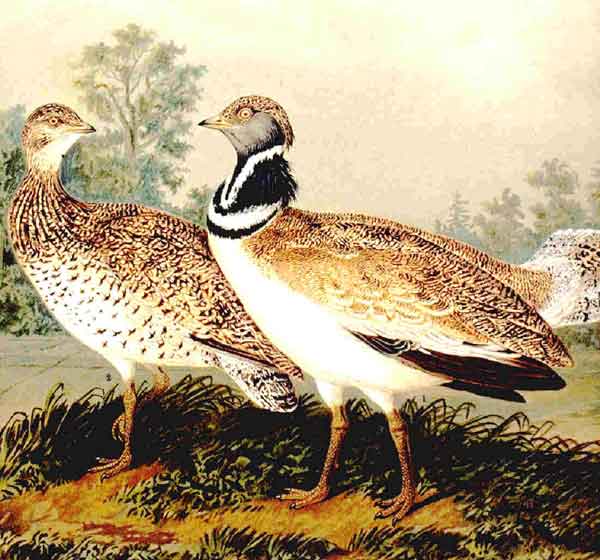
Tetrax tetrax (*)
Superregnum: Eukaryota
Regnum: Animalia
Subregnum: Eumetazoa
Cladus: Bilateria
Cladus: Nephrozoa
Superphylum: Deuterostomia
Phylum: Chordata
Subphylum: Vertebrata
Infraphylum: Gnathostomata
Megaclassis: Osteichthyes
Superclassis: Sarcopterygii
Superclassis: Tetrapoda
Cladus: Reptiliomorpha
Cladus: Amniota
Classis: Reptilia
Cladus: Eureptilia
Cladus: Romeriida
Subclassis: Diapsida
Cladus: Sauria
Infraclassis: Archosauromorpha
Cladus: Crurotarsi
Divisio: Archosauria
Cladus: Avemetatarsalia
Cladus: Ornithodira
Subtaxon: Dinosauromorpha
Cladus: Dinosauriformes
Cladus: Dracohors
Cladus: Dinosauria
Ordo: Saurischia
Cladus: Eusaurischia
Cladus: Theropoda
Cladus: Neotheropoda
Cladus: Averostra
Cladus: Tetanurae
Cladus: Avetheropoda
Cladus: Coelurosauria
Cladus: Tyrannoraptora
Cladus: Maniraptoromorpha
Cladus: Maniraptoriformes
Cladus: Maniraptora
Cladus: Pennaraptora
Cladus: Paraves
Cladus: Eumaniraptora
Cladus: Avialae
Infraclassis: Aves
Cladus: Euavialae
Cladus: Avebrevicauda
Cladus: Pygostylia
Cladus: Ornithothoraces
Cladus: Euornithes
Cladus: Ornithuromorpha
Cladus: Ornithurae
Cladus: Carinatae
Parvclassis: Neornithes
Cohors: Neognathae
Ordo: Otidiformes
Familia: Otididae
Genus: Tetrax
Species: Tetrax tetrax
Name
Tetrax tetrax (Linnaeus, 1758)
Synonyms
Otis tetrax (protonym)
References
Linnaeus, C. 1758. Systema Naturae per regna tria naturæ, secundum classes, ordines, genera, species, cum characteribus, differentiis, synonymis, locis, Tomus I. Editio decima, reformata. Holmiæ: impensis direct. Laurentii Salvii. i–ii, 1–824 pp DOI: 10.5962/bhl.title.542: 154. Reference page.
IUCN: Tetrax tetrax (Near Threatened)
Vernacular names
العربية: حباري صغيرة
azərbaycanca: Bəzgək
башҡортса: Биҙгәләк
беларуская: Стрэпет
български: Стрепет
brezhoneg: Otiz bihan
català: Sisó comú
čeština: Drop malý
Cymraeg: Ceiliog gwaun bychan
dansk: Dværgtrappe
Deutsch: Zwergtrappe
Ελληνικά: Χαμωτίδα
English: Little bustard
Esperanto: Malgranda otido
español: Sisón común
eesti: Väiketrapp
euskara: Basoilo txiki
فارسی: زنگولهبال
suomi: Pikkutrappi
français: Outarde canepetière
galego: Sisón
עברית: חובה קטנה
hrvatski: Mala droplja
magyar: Reznek
հայերեն: Արոս
íslenska: Dvergdoðra
italiano: Otarda minore
日本語: ヒメノガン
ქართული: სარსარაკი
қазақша: Безгелдек
kurdî: Berçirik
кыргызча: Кадимки безбелдек
lietuvių: Mažasis einis
latviešu: Mazā sīga
македонски: Мала дропла
эрзянь: Паксясараз
Nederlands: Kleine trap
norsk: Dvergtrappe
ирон: Сунсунæг
polski: Strepet
پنجابی: نکا بسٹرڈ
português: Sisão
română: Spârcaci
русский: Стрепет
slovenčina: Drop malý
svenska: Småtrapp
Türkmençe: Bezbeltek
Türkçe: Mezgeldek
татарча/tatarça: Дала кошы
українська: Хохітва
oʻzbekcha/ўзбекча: Bizgʻaldoq
Tiếng Việt: Ô tác châu Âu nhỏ
中文: 小鸨
The little bustard (Tetrax tetrax) is a bird in the bustard family, the only member of the genus Tetrax. The genus name is from Ancient Greek and refers to a gamebird mentioned by Aristophanes and others.[3]
Contents
Distribution
It breeds in Southern Europe and in Western and Central Asia. Southernmost European birds are mainly resident, but other populations migrate further south in winter. The central European population once breeding in the grassland of Hungary became extinct several decades ago. The species is declining due to habitat loss throughout its range. It used to breed more widely, for example ranging north to Poland occasionally.[4] It is only a very rare vagrant to Great Britain despite breeding in France. On 20 December 2013, the Cypriot newspapers 'Fileleftheros' and 'Politis', as well as news website 'SigmaLive', reported the discovery of a dead little bustard in the United Nations Buffer Zone. The bird had been shot by poachers hunting illegally in the zone. The shooting was particularly controversial amongst conservationists and birders since the little bustard is a very rare visitor to Cyprus and had not been officially recorded in Cyprus since December 1979.[5]
Description
Although the smallest Palearctic bustard, the little bustard is still pheasant-sized at 42–45 cm (17–18 in) long with a 90–110 cm (35–43 in) wingspan and a weight of 830 g (29 oz).[6] In flight, the long wings are extensively white. The breeding male is brown above and white below, with a grey head and a black neck bordered above and below by white.
Egg, Collection Museum Wiesbaden
The female and non-breeding male lack the dramatic neck pattern, and the female is marked darker below than the male. Immature bustards resemble females. Both sexes are usually silent, although the male has a distinctive "raspberry-blowing" call: prrt.
Diet
This species is omnivorous, taking seeds, insects, rodents and reptiles.
Breeding
Like other bustards, the male little bustard has a flamboyant display with foot stamping and leaping in the air. Females lay 3 to 5 eggs on the ground.
Habitat
The bird's habitat is open grassland and undisturbed cultivation, with plants tall enough for cover. Males and females do not differ markedly in habitat selection.[7] It has a stately slow walk, and tends to run when disturbed rather than fly. It is gregarious, especially in winter.
Tracking of male Little Bustards has revealed that they are nocturnal migrants that make frequent stopovers in non-irrigated and irrigated croplands to reach more productive agricultural post-breeding areas. [8]
References
BirdLife International (2018). "Tetrax tetrax". IUCN Red List of Threatened Species. 2018: e.T22691896A129913710. doi:10.2305/IUCN.UK.2018-2.RLTS.T22691896A129913710.en. Retrieved 11 November 2021.
"Appendices | CITES". cites.org. Retrieved 14 January 2022.
Jobling, James A (2010). The Helm Dictionary of Scientific Bird Names. London: Christopher Helm. p. 383. ISBN 978-1-4081-2501-4.
Tomek, Teresa; Bocheński, Zygmunt (2005). "Weichselian and Holocene bird remains from Komarowa Cave, Central Poland". Acta Zoologica Cracoviensia. 48A (1–2): 43–65. doi:10.3409/173491505783995743.
"Little Bustard Shot". cyprusbirdingtours.com. 17 December 2013. Retrieved 15 March 2014.
"BTO BirdFacts: Little Bustard". British Trust for Ornithology. Retrieved 13 January 2018.
Devoucoux, Pierrick; Besnard, Aurélien; Bretagnolle, Vincent (2019). "Sex-dependent habitat selection in a high-density Little Bustard Tetrax tetrax population in southern France, and the implications for conservation". Ibis. 161 (2): 310–324. doi:10.1111/ibi.12606. ISSN 1474-919X.
Alonso, H.; Correia, R.A.; Marques, A.T.; Palmeirim, J.M.; Moreira, F.; Silva, J.P. (2020). "Male post‐breeding movements and stopover habitat selection of an endangered short‐distance migrant, the Little Bustard Tetrax tetrax". Ibis. 162 (2): 279–292. doi:10.1111/ibi.12706. hdl:10451/46413.
Retrieved from "http://en.wikipedia.org/"
All text is available under the terms of the GNU Free Documentation License

